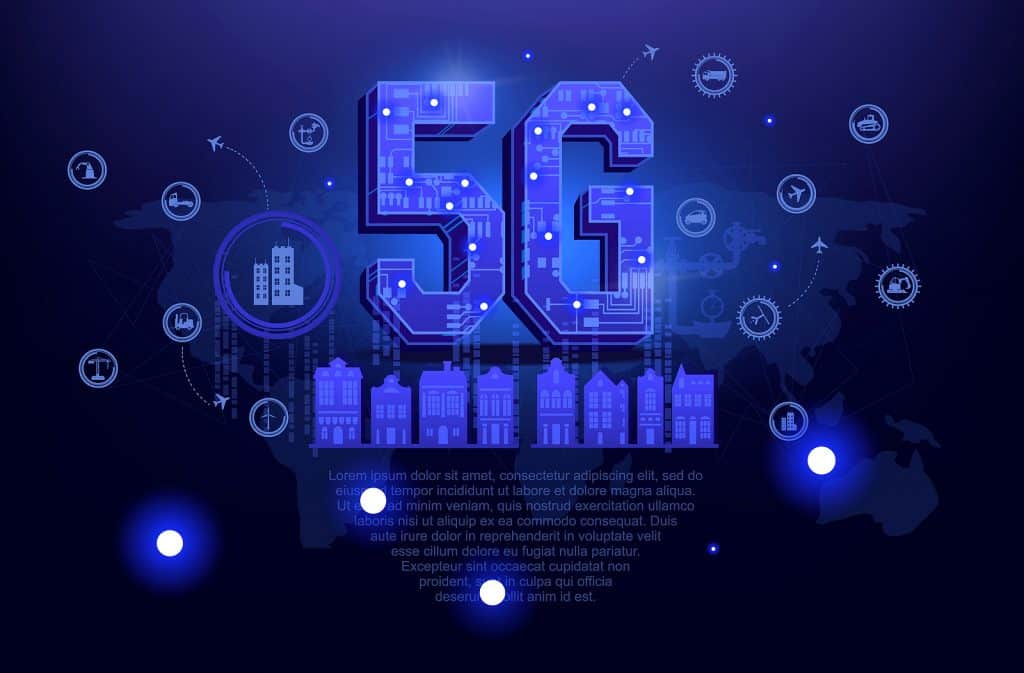What Is 5G?
5G meaning the 5th Generation of wireless technology, is the latest in a set of standards describing cellular networks. Each generation (1G, 2G, 3G, etc.) is based on a set of telephone network standards that describe the technological implementation of the system.
Table of Contents
Toggle1G was analog cellular. 2G technologies, such as CDMA, GSM, and TDMA, were the first generation of digital cellular technologies. With 3G technologies like EVDO, HSPA, and UMTS, digital performance levels increased, bringing speeds from 200kbps (kilobits per second) to a few megabits per second (there are 8 megabits in a Megabyte).
With the arrival of 4G technologies such as WiMAX and LTE, speeds scaled up to hundreds of megabits, even approaching gigabit-levels.
5G network speeds are taking this up a quantum level, with download speeds of around 1GBps (Gigabits per second) having been observed, and a theoretical maximum speed of around 10GBps at the current state of technology.
What Is 5G Technology?
There are three different methods for building a 5G network, depending on the type of assets that a wireless carrier has.
- Low-Band Technology: Low-band 5G networks provide a wide coverage area, but are only about 20% faster than 4G. Carriers building out a low-band network for 5G can use much of their existing 4G LTE infrastructure.
- Mid-Band Technology: Mid-band spectrum technology provides faster speeds and lower latency (the time lag between sending out a signal from a device, and the signal arriving in a usable form at its destination) than low-band. However, it can’t penetrate buildings as effectively as the low-band spectrum. Again, carriers may reuse some of their existing 4G LTE infrastructure in the transition to 5G.
- High-Band Technology: High-band 5G networks can provide super-fast speeds, but their signals don’t travel well and have difficulty in moving through hard surfaces. At the highest speed levels, millimeter-wave or mmWave technology is employed, in the 20-100GHz (gigahertz) range. Because of the short-range, network carriers must expand their infrastructure to include numerous small cell sites – antennas attached to utility poles, buildings, and other solid objects to maintain network coverage in densely populated areas.
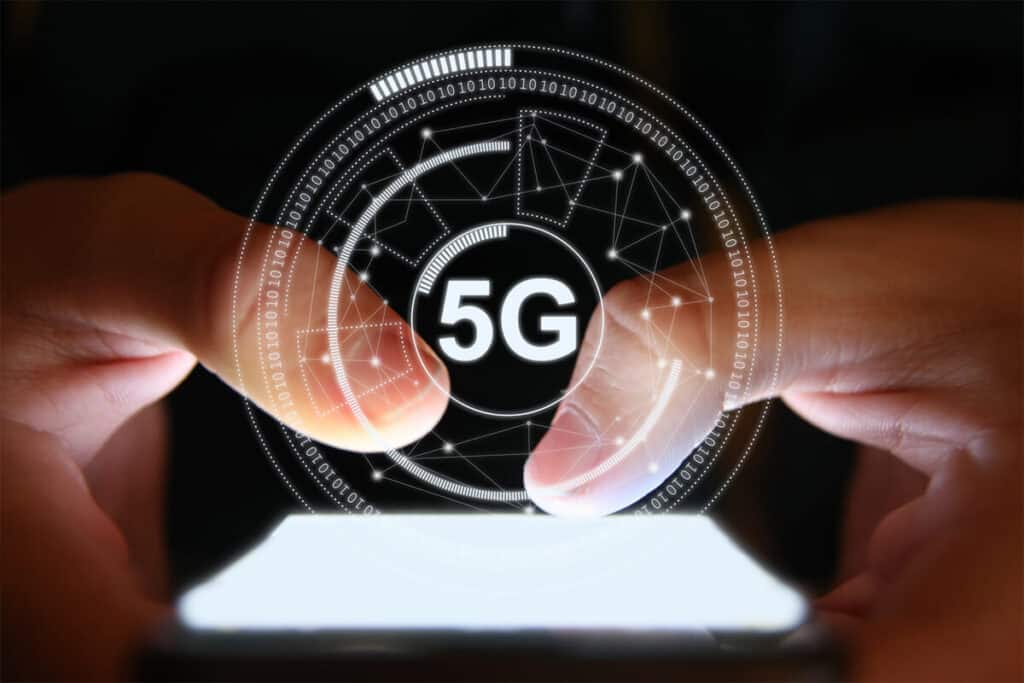
Low Latency Technologies
One of the major selling points of 5G is the vastly lower latency that it offers in comparison to previous generations of mobile. As a case in point, the response time of 4G LTE systems is typically around 20-30ms (milliseconds).
With 5G enhanced mobile broadband technology, this network latency drops to around 4-5ms. And with 5G URLLC (Ultra-Reliable Low Latency Communications) systems technology, this reduces down to a single millisecond.
Performance like this is achieved through significant advances in mobile device technology and mobile network architecture. Significant changes in both the Core Network (Core) and Radio Access Network (RAN) are required to deliver low latency.
In the redesigned 5G core network, signaling, and distributed servers, the key technology strategy is to move content closer to the end-user, and to shorten the path between devices for critical applications.
For this kind of “edge computing” application, it’s possible to store a copy or cache of popular content in local servers, so the time to access it is reduced.
For the low latency of 5G, the Radio Access Network (RAN) must be re-configured so that it is both highly flexible and software configurable. This enables the RAN to support the very different characteristics of the different types of services that the 5G system must cope with.
A virtual, dynamic, and configurable RAN allows the network to perform at very low latency and high data throughput. It also allows the mobile network to adjust to changes in network traffic, network faults, and new requirements.
The History of 5G
The answer to the question “Who invented 5G?” isn’t a straightforward matter of “Person X” or “Company Y.” Like all the previous standards governing mobile technology, 5G came about as a result of input from several quarters, together with consultation by the relevant authorities, and due reference to the generations of wireless technology that came before.
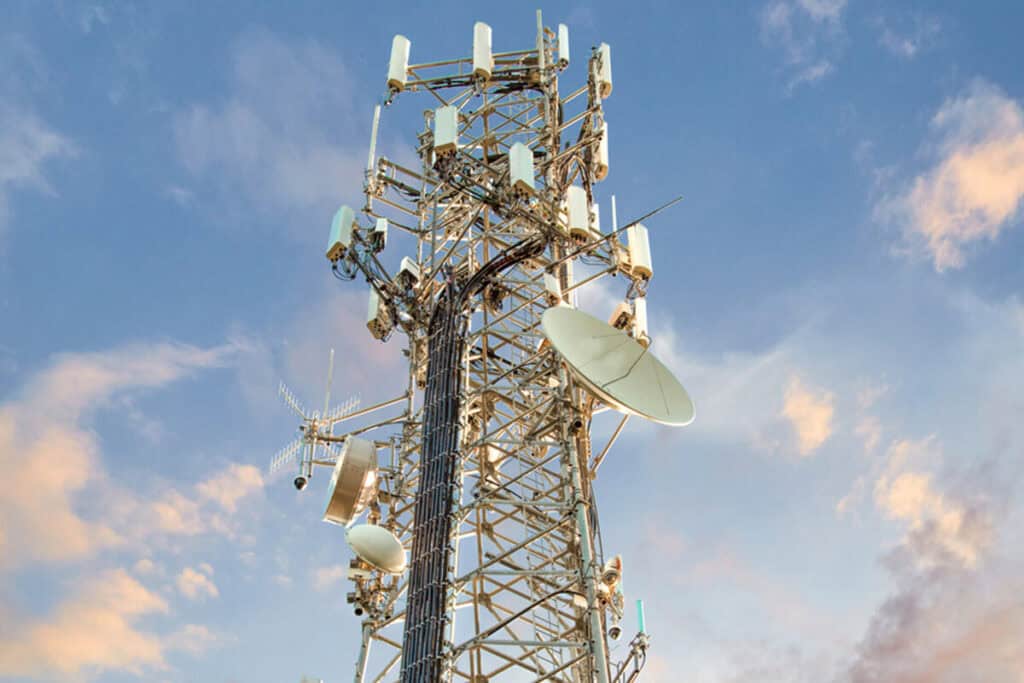
So, When Was 5G Introduced?
The International Telecommunication Union (ITU) is an agency of the United Nations which develops technical standards for communication technologies and sets the rules for radio spectrum usage and telecommunications interoperability.
In 2012, the ITU created a program called “IMT for 2020 and beyond” (IMT-2020) to research and establish minimum requirements for the 5th Generation of wireless. After years of consultation, the ITU published a draft report with 13 minimum requirements for 5G, in 2017.
Based on these minimum requirements, the 3rd Generation Partnership Project (3GPP), a collaboration of telecommunications standards organizations, set to work on creating standards for 5G.
The 3GPP completed its non-standalone (NSA) specifications for 5G in December 2017, and it’s standalone (SA) specifications in June 2018. The NSA specifications use existing LTE networks for 5G rollout, while SA will use a next-generation core network specifically architected for 5G.
Today’s network carriers will build 5G networks based on other technologies that are faster than today’s networks but rely on existing infrastructure.
Other notable events in the history of 5G relate to the testing and trials that led to its first appearances. We can summarize key occurrences in the 5G timeline, as follows:
- 2011: The first studies are undertaken, considering millimeter wave as a key component for cellular 5G networks.
- 2012: 5G research is conducted in various countries, including Japan, the United States, and the United Kingdom.
- 2013: While Nippon Telegraph and Telephone lead global 5G research in Japan, Samsung in South Korea announces the development of the technology. India and Israel start a program. Chinese companies, including Huawei, begin research on 5G.
- 2014: Japan establishes its 5G Mobile Forum. A 5G mobile strategy begins in South Korea. The European Commission earmarks €700 million for 5G research.
- 2015: In the same year that the International Telecommunication Union’s IMT-2020 framework is published, setting out the general requirements and future development of the next-generation mobile technology, Verizon creates the 5G Technology Forum (5GTF), bringing together key partners like Ericsson, Qualcomm, Intel, and Samsung, for consultation and brainstorming on ways to move the entire 5G ecosystem forward.
- 2016: Huge amounts of bandwidth in the underused high-band spectrum are freed up in the United States for 5G. Chinese companies begin conducting technical trials. The European Union adopts an action plan with the objective of launching 5G services in all 28 member states by the end of 2020.
- 2017: 5GTF work helps accelerate the release of the 3GPP 5G New Radio (NR) standard in December of 2017. 77 operators in 49 countries complete 5G trials. The non-standalone (NSA) mode of 5G NR specifications are approved by 3GPP.
- 2018: Verizon uses the 5G TF standard to launch its 5G Home service in the US in LA, Sacramento, Houston, and Indianapolis. A number of countries start launching limited 5G networks in selected locations.
- 2019: Verizon subscribers in parts of Chicago and Minneapolis become the first in the world to have a 5G-enabled smartphone connected to a 5G network. The first countrywide commercial 5G network deployment begins in South Korea.
- 2020: 5G services are expected to be launched in many major cities. 5G smartphone shipments are estimated to number at around 260 million units within the year.
When will 5G come out? As you can see from the timeline, it’s been around since in-country trials began in 2017.
All of the major US carriers are working furiously to build out 5G networks, yet deployment across the entire country will probably take several years.
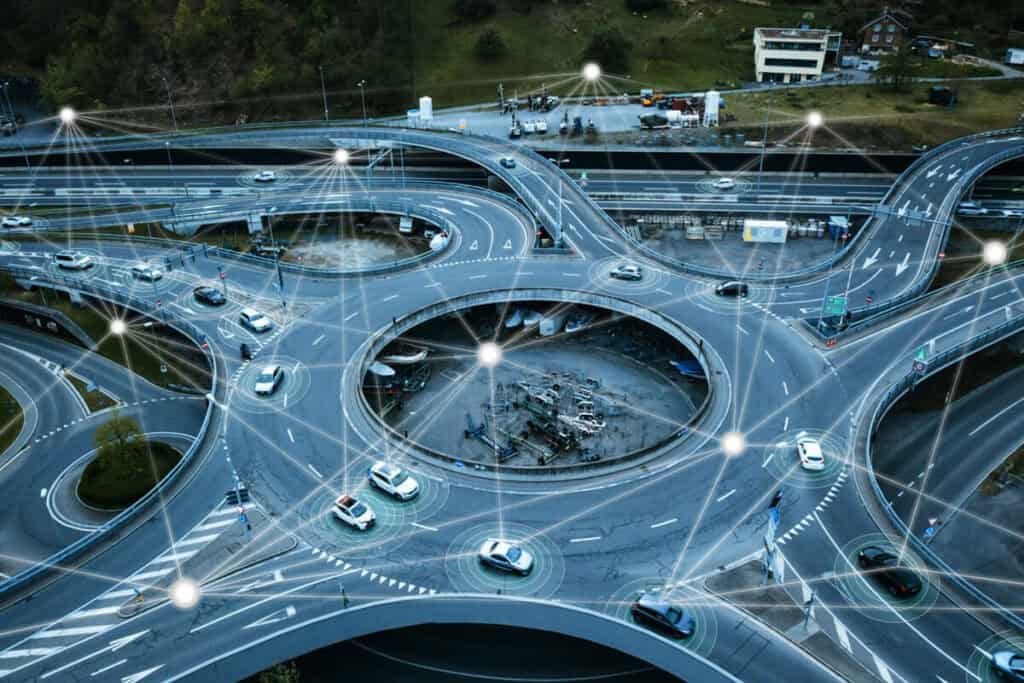
Why Is It Important?
With its promise of vastly higher data transfer speeds, minimal latency, increased reliability of networks, and the ability to simultaneously connect enormous numbers of devices, there are serious implications for how this 5th Generation of wireless networking will affect technology, commerce, and daily life.
Higher speeds and reduced latency mean that 5G cells will be able to communicate almost instantly. This implies that a real-time internet is on the way, with a real-time cloud, and the potential to create a new class of electronic devices that can exchange data and communicate quickly enough to make near-real-time decisions.
This would enable businesses and service providers to deliver a new kind of customer experience, with instantaneous access to products and platforms, and the capacity to stream live and immersive environments incorporating virtual reality (VR), augmented reality (AR), and artificial intelligence (AI).
With remote connectivity and intelligent automation powered by super-fast 5G networks, operations within various sectors – health care, manufacturing, transport, etc., etc. – will have the potential to tap into a new set of techniques and technologies.
Emerging technologies such as smart cities and infrastructure could benefit from the rapid response and massive connectivity of 5G in linking devices of the Internet of Things (IoT), and expanding their range of capabilities.
And minimal latency may finally make it feasible for autonomous or self-driving vehicles to not only steer a safe path through city streets and highways but to orchestrate and coordinate their movement with each other – although it may take several years for the relevant technologies to develop to this level.
Another reason why 5G is important is from a commercial perspective. 5G and its related technologies are already generating a great deal of interest. Shipments of 5G-compatible smartphones are expected to be in the range of 175 million to 225 million this year.
On the enterprise side, private 5G network services are expected to drive new business uses. 5G applications like real-time automation are predicted to generate $107 billion by 2030, and connected vehicles could produce a market worth $89 billion by 2030.
The Future
As with any developing technology, the future of 5G remains largely uncertain – a view amplified by the wide divergence in observed levels of performance from the 5G networks that are running to date.
In countries like China and South Korea, for example, while the 5G rollout has gone further than in the US, network speeds haven’t been markedly different from 4G networks – and in terms of running smartphone applications, there’s been little difference in performance.
In the US, 5G network performance has been somewhat better, with, for example, average download speeds of around 190Mbps, and a maximum speed of 690Mbps (Megabits per second) observed on Sprint’s 2.5GHz spectrum service.
Tens of billions of dollars are currently being invested for spectrum and infrastructure, with all national carriers well on their way to widespread 5G coverage.
One focus for the future is likely to be the harnessing of fiber optics technology in creating converged networks for 5G. A converged fiber network of this type can simultaneously support wired and wireless mobile applications.
Early experience with 5G centers on its significant enhancement of the mobile experience. Looking ahead, 5G development is expected to focus on the true enablement of the Internet of Things (IoT), with billions of connections to the network – up to 5 billion networked devices in North America alone, by 2023.
The business-to-business (B2B) opportunities enabled by 5G will represent a $700 billion market by 2030 for network operators, according to some estimates.
In addition to real-time automation, burgeoning 5G technology and the IoT are expected to give rise to applications including automated factories, smart buildings, drones, autonomous connected vehicles, public surveillance and security networks, and precision agriculture.

Benefits of 5G
Greatly enhanced speed is one of the principal advantages of 5G. Data transfer rates in the region of 1-20Gbps (Gigabits per second) represent a step up from the previous generation, 4G LTE, of a factor from 10 to 100. At a practical level, these enhancements are enabling 5G consumers to download content more quickly.
Though improved speed is a major driver of the shift towards the new generation of mobile, among the benefits of 5G that’s likely to have the most significant impact is low latency.
Lag or latency is the response time between the sending out of a wireless signal from one device and its reception in a usable form at its destination.
For the quickest existing networks (4G LTE), this lag time can last around 20 milliseconds (20ms). With the fastest 5G networks, this latency can be reduced to as little as 1 millisecond – about the time it takes for a flash on a normal camera.
Besides speed and responsiveness, what will 5G bring to the table in terms of our digital ecosystem? Since 5G is designed to connect a far greater number of devices than a traditional cellular network, operations within the still-growing Internet of Things (IoT) will receive a boost. The 5G network is also more versatile, with the ability to adjust its performance in catering for devices with different needs.
What will 5G be used for? In the consumer market, a number of 5G-capable smartphones are already available, with more due to launch later this year, extending access to mobile telecommunications users.
Buyers with access to a 5G network will be able to download videos, games, and music up to five times faster than 4G LTE and enjoy greater call and image clarity.
By enabling billions of new connections with speed, low latency, and security, 5G could make X2X (everything-to-everything) links a practical reality, acting as a critical enabler for Massive IoT, Connected Autonomous Vehicles (CAVs), remote critical control, and numerous other applications.
How Does It Work?
How does 5G work? To answer that, it’s useful to have an understanding of how the previous generations of mobile technology operated and how 5G builds on that.
Data travels along the radio portion of the electromagnetic spectrum, which includes frequencies between 3kilohertz (kHz) and 300 gigahertz (GHz). 1G or the first generation of cellular network technology operated on frequency bands between 850MHz (megahertz) and 1,900MHz. 2G and 3G expanded to 850MHz to 2,100 MHz, and 4G occupied the range from roughly 600MHz to 2.5GHz.
At its quickest, 5G operates in the high-frequency bands of the millimeter wave (mmWave) spectrum – specifically, those in the 28GHz to 38GHz range. 5G signals will typically use wavelengths (between 30 and 300GHz) that are measured in millimeters.
These very high-frequency signals provide an enormous amount of bandwidth, enabling many more simultaneous connections to exist on the same network.

What Frequency is 5G?
5G frequency spectrum covers three 5G wavelength variations: low, mid, and high-band. Low-band 5G offers the lowest speeds but has the greatest coverage and ability to move through solid barriers.
High-band 5G (about 28GHz) has the shortest range, and may only be able to span a few blocks of any given area. With low-band 5G (which transmits at around 600MHz), a single tower could potentially serve customers for hundreds of square miles.
How does 5G technology work? In many instances, it will function as an extension to existing cellular infrastructure. For the implementation of 4G services, communications companies typically built large cell phone towers to transmit signals across a geographical area.
In rolling out 5G, service providers have been installing their equipment (known as small cells) on existing telephone lines and buildings. These cells typically have a range of around 820 feet (250 meters), and large numbers of them are required to maintain 5G coverage at higher speeds in densely populated areas.
In the US, Verizon has been building out capacity for its 5G Ultra Wideband service with small cells, extensive radio wave spectrum holdings, and fiber-optic cable.
Small cell transmitters are roughly the size of a laptop computer and are strategically placed in locations where usage demands are highest. Fiber-optic cables may contain dozens to hundreds of optical fibers within a single casing and are used in transferring data signals from the small cells to the 5G core network at the speed of light.
People Also Asked
Why Is 5G Dangerous?
Short answer: it isn’t – or at least, it hasn’t been proved to be dangerous to human health by any studies conducted through conventional science.
Perhaps the greatest danger of 5G frequency band is the amount of hype and poorly informed rumor surrounding its potential or presumed health risks.
In particular, certain activists fear that radiofrequency or RF radiation from 5G wireless service could be dangerous to public health, and are demanding more research before carriers deploy the technology.
Elsewhere, false conspiracy theories are linking 5G wireless networks with the origins of the coronavirus (COVID-19). These include rumors that the rollout of 5G technology in Wuhan, China, caused the first outbreak, and that 5G radiation caused the SARS virus to mutate into COVID-19.
Neither claim is true – but belief in these theories has resulted in acts of extreme vandalism, such as the arson attacks against cellular infrastructure in the UK.

What Countries Have Banned 5G?
Action by national governments against 5G has largely been focusing on the role played by the Chinese company Huawei, which is one of the world’s principal providers of 5G network technology and expertise.
In January 2020, the US unveiled a high-profile case against Huawei, including allegations of fraud, stealing of trade secrets, and the skirting of US sanctions against Iran.
Huawei’s alleged links with the Chinese government have also been cited as evidence that the smartphone and wireless technology company may be serving as a vehicle for China to spy on its rivals.
These investigations, together with the ongoing trade disputes between the USA and China, have put pressure on America’s allies to take punitive action against Huawei.
The UK has banned the company from contributing core components to its rollout of 5G technology, cutting Huawei’s share in the country’s new network to 35%. In addition, companies in the UK are under orders to phase out elements of Huawei technology from their core infrastructure by 2027.
New Zealand and Australia have put total bans on Huawei technology into effect as they roll out their own 5G networks.
In Europe, Huawei is now supplying a third of telecommunication systems, so an outright ban on its technology would be problematic.
Germany and France, which are considering bans, have said they will increase security measures to safeguard against backdoors into communication channels that may be part of Huawei’s technology.
Denmark, Sweden, Belgium, and several other European countries are still on the fence about possible bans.

Is 5G Dangerous to Birds?
The “5G kills birds” theory can be traced back to a 2019 Facebook post by John Kuhles, who, according to the fact-checking site Snopes, “runs several anti-5G conspiracy websites and social media pages.”
The post claimed that a recent mass die-off of European Starlings in the Netherlands was caused by a 5G frequency range antenna test.
Despite the fact that the 5G test actually took place months before the die-off event, other Facebook pages, and health blogs picked up the post.
And after the release of the Indian sci-fi blockbuster 2.0 (which depicts scenes of electromagnetic radiation from cell towers wiping out bird populations), some Indian news organizations published stories on the movie, adding that “birds died in The Netherlands due to 5G.”
Fans of 2.0 then discovered a 2012 YouTube video in which University of Southern California professor Travis Longcore discusses his study revealing that communication towers kill 6.8 million birds annually.
However, these bird deaths occurred due to the lights used on communication towers disorienting their flight path, not because of the electromagnetic radiation they give out.
This fact is backed up by hard science. “Radio wave emissions above 10MHz from radio transmission antennas (including cell telephone towers) are not known to harm birds,” as confirmed by Joe Kirschvink, a biophysicist at the California Institute of Technology who specializes in magnetics.
Kirschvink was also involved in a related study in 2014 – at the same time that a group of biologists in Germany found that low-level magnetic radiation, such as AM radio waves, could interfere with the ability of migratory birds to orient themselves using the Earth’s magnetic field.
Kirschvink issued a strong disclaimer in his own study, to the effect that: “Modern-day charlatans will undoubtedly seize on this study as an argument for banning the use of mobile phones, despite the different frequency bands involved.”
Conclusion: 5G is not dangerous to birds.

How Does 5G Affect the Human Body?
The frequencies emitted in X-rays, gamma rays, or ultraviolet light (sunlight, UV lamps, etc.) is classified as ionizing radiation, which is strong enough to damage human cells and DNA. In fact, prolonged exposure to these sources has long been recognized as posing a cancer risk.
By contrast, the radio signals that mobile phones and cell towers transmit are of lower band frequencies, which also include the radiation transmitted by AM radio, microwave ovens, and 5G network infrastructure.
These are categorized as non-ionizing radiation, which isn’t able to directly harm human DNA. They are generally considered harmless, except for their potential to heat up human cells at a very close range and prolonged exposures.
With the safety limits already in place, leading national authorities such as the Food and Drug Administration (FDA), the National Cancer Institute, and the Federal Communications Commission (FCC) maintain that there is little to no health risk from using mobile phones – be they 5G, or otherwise.
Some theories have claimed that 5G wireless may have made people more susceptible to the coronavirus by weakening their immune systems.
But again, leading authorities such as the International Commission on Non-Ionizing Radiation Protection maintain that there is no credible scientific evidence for this.
And the National Cancer Institute, which has an extensive web resource covering cell phone health research, observes that: “The most consistent health risk associated with cell phone use is distracted driving and vehicle accidents.”
Can It Harm You?
The radiation given off by cell phones operating on 5G networks is at the low-energy end of the electromagnetic spectrum, making it much safer than high-energy ionizing radiation such as X-rays and gamma rays.
Ionizing radiation has enough energy to ionize an atom or molecule and damage cell DNA potentially causing cancer, whereas the non-ionizing radiation associated with 5G radio waves (and all the previous generations of mobile technology) cannot do this.
While the radio frequency or RF radiation employed by 5G does not cause cancer by damaging the DNA in human cells, studies are still ongoing regarding the effects of non-ionizing radiation.
For now, a number of leading authorities in the health and regulation sphere have made their assessments on the implications of 5G and wireless technologies.
The US Food and Drug Administration (FDA) is not only responsible for protecting public health through the control and supervision of food and medicine, but also in matters relating to electromagnetic radiation emitting devices.
According to an FDA statement from 2018: “the current safety limits for cell phone radiofrequency energy exposure remain acceptable for protecting the public health.” In recent questioning concerning 5G, FDA officials have restated this view.
The US Environmental Protection Agency (EPA) and the US National Toxicology Program (NTP) have not formally classified RF radiation as cancer-causing.
Though the World Health Organization’s International Agency for Research on Cancer (IARC) classifies RF radiation as “possibly carcinogenic to humans” due to the findings of a possible link in at least one study between cell phone usage and a specific type of brain tumor in rats, the IARC considers the overall evidence to be “limited.” You should also note that the IARC puts coffee and talc-based body powders in the same “possibly carcinogenic” category.
Is 5G a Weapon?
5G isn’t a weapon in itself – but there are ways in which it could potentially be weaponized.
5G is intended not only to improve on the performance of mobile communication networks but also to link digital systems that need enormous amounts of data in order to work automatically.
And though the 5G commercial network will be built and activated by private companies, military experts predict that 5G systems will play an essential role in the use of hypersonic weapons – including missiles bearing nuclear warheads that can travel at speeds greater than Mach 5 (five times the speed of sound).
By minimizing network latency or time lag, 5G technology could enable these weapons to change direction in a fraction of a second, to avoid interceptor missiles.
5G networks could also allow military strategists and command posts to gather, analyze, and transmit enormous quantities of data in a very short time. And 5G automated systems could orchestrate responses to data analysis or incoming attacks in real or near real-time.
An interesting sideline on 5G weaponization concerns a non-lethal crowd control device called the Active Denial System (ADS), which was developed by the US Department of Defense.
It works by firing a high-powered beam of 95GHz waves at a target – if the target is human, anyone caught in the beam will feel as if their skin is burning. The burning sensation ceases once the target leaves the range of the beam.
The 95GHz waves that the ADS employs fall within the millimeter-wave (mmWave) frequency spectrum used by some of the higher-speed 5G networks. But the concentrations of energy required to generate an ADS beam are way in excess of anything produced by 5G cell towers or equipment.
How Do You Protect from 5G?
The highest speed 5G networks operate on millimeter waves, which have extremely large wavelengths and extremely small frequencies. These waves are generally unable to penetrate solid objects such as buildings or trees, so 5G base stations and cell towers will be planted at shorter distances (as “small cells”), to create an environment where radio frequency or RF signals can saturate an area.
This level of saturation with a form of radiation that’s still largely untested is causing concerns.
To reduce your exposure to 5G and other radio frequency emissions, you can:
- Keep phones, computers, routers, and other devices away from your body, especially when you’re sleeping. Instead of carrying a phone around in your pocket, put it in your bag.
- Use an EMF (Electro-Magnetic Frequency) measuring device to identify high-intensity areas of radiation near you. This will enable you to locate areas where you can spend your time with minimum exposure.
- Several vendors are offering EMF cases and shields for phones, routers, computers, and televisions, which claim to minimize the radio frequency (RF) impact by up to 92%.
- Keep up to date with 5G news, and lookup methods suggested by doctors and experts on how you can deal with the health implications they identify.

What Is the Difference Between 4G and 5G?
In 2008, the International Telecommunications Union (ITU) laid down its specification for the 4th Generation of mobile technology, or 4G. In terms of download speed, this stipulated a minimum specification for 4G of 100Mbps (Megabits per second).
Note that there are 8 megabits (Mb) in a megabyte (MB). However, this stipulation was so high that even today, equipment manufacturers and network providers have been unable to meet it in full.
As a workaround, manufacturers and network providers came up with the concept of LTE, which is short for “Long-Term Evolution,” to describe a network standard that approaches the values specified for true 4G. 4G LTE can currently support interactive multimedia, voice, and video, with maximum speeds of up to 20Mbps.
For 5G, download speeds of around 1GBps (Gigabits per second) have been observed, with a theoretical maximum of around 10GBps at the current state of technology. 1GBps equals 1,000MBps.
In practice, however, 5G speeds assume a range of values from around 300MBps to 1GBps, which depend on the technology providing the network, the level of network congestion, the device you use, and other factors.
It’s in terms of latency (a measure of the time it takes for information sent from a device to be usable by the receiver) that 5G truly has the edge over its predecessor.
With 4G networks, an average latency of around 50ms (milliseconds) is not uncommon, with the best performing networks reducing this to around 20ms. Note that it takes at least 10ms for an image seen by the human eye to be processed by the brain.
5G gives an average latency of around 10ms, reducing down to around 2ms on the best performing networks. It’s theoretical best is 1ms of latency, which is an almost real-time response.
In other considerations, 5G wastes less power than 4G LTE, which uses substantially more energy than the newer generation. 5G networks also provide better connectivity, enabling potentially millions of devices in densely populated areas to connect concurrently without experiencing latency or speed issues.
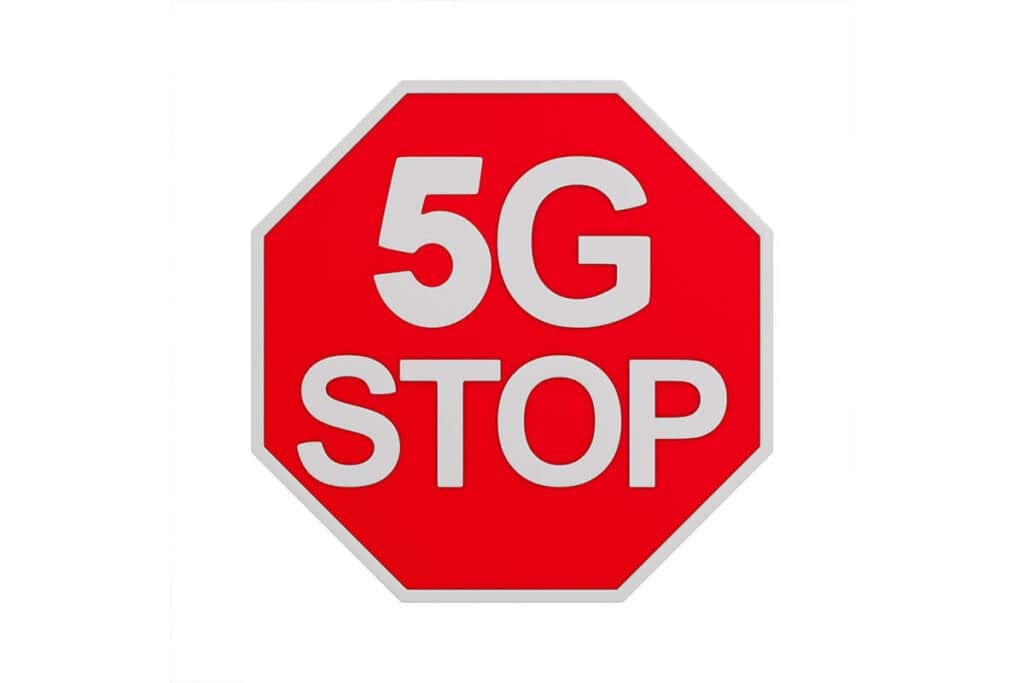
Is 5G Dangerous?
Much has been said online and in the popular press about the damaging effects of 5G radiation – despite plenty of scientific evidence to the contrary.
Some conspiracy theories also claim that 5G networking technology caused the SARS virus to mutate into COVID-19, and is responsible for the coronavirus pandemic, which is also untrue.
After seven years of research, the International Commission on Non-Ionizing Radiation Protection (ICNIRP) released 2020 guidelines on limiting exposure to electromagnetic fields. These guidelines include information about 5G.
According to the commission, the main effect that radio frequency or RF electromagnetic fields of the type associated with 5G and other mobile networks have on the human body is increased temperature of exposed tissue.
Radio frequency exposure and increased temperature can be dangerous above a certain threshold – but that threshold is unlikely to be breached by normal cell phone usage under 5G.
The ICNIRP has also stated that there is no evidence that electromagnetic fields cause health effects such as cancer, electro-hypersensitivity, or infertility. The only two recognized health effects are nerve stimulation at ranges up to 10MHz, and heating from 100kHz.
Will 5G replace WiFi?
A number of 5G providers are rolling out or preparing to offer fixed wireless services for home internet. For example, Starry Internet in Boston uses 5G millimeter-wave bands on a fixed-wireless network to deliver internet to apartment complexes and some residential buildings in Los Angeles, Denver, New York City, Boston, and Washington DC.
And Verizon currently offers its 5G Home internet service in select parts of Chicago, Sacramento, Los Angeles, Houston, and Indianapolis.
The problem is that 5G fixed wireless availability is extremely limited for now, and it’s hard to say whether 5G home internet will be better or faster than DSL, fiber, or cable.
Service providers will need to build more robust networks if they’re to guarantee faster speeds and performance for 5G and the emerging WiFi 6 standards.
Will 5G Be Free?
No – at least, not for now. Putting the necessary infrastructure and services in place for 5G is putting a considerable financial burden on the major network carriers. And for the moment, they’re passing that cost load onto their consumers.
Broadly speaking, the difference in average cost between 5G and 4G unlimited data plans varies from $5 to $72 per month.
Verizon, for example, offers 5G plans with prices on average $18 higher than 4G, but these services come with free roaming in Canada and Mexico, along with Apple Music.
Sprint doesn’t charge a fee but requires subscribers to sign up for its $80 “Unlimited Premium” plan. Two of AT&T’s unlimited plans include 5G (their “Extra” plan costs $40 per line a month, and their “Elite” plan is $50 per line a month).
Can I Get 5G in My Home?
Using a technology called Fixed Wireless Access (FWA), Verizon’s 5G Home service offers consumers a 1Gbps (Gigabit per second) in-home connection via 5G.
T-Mobile has announced that it plans to offer a 5G-based fixed wireless broadband service to more than half of US households by 2024. And AT&T has been weighing options for offering a 5G-based FWA service.
Does 5G Require a New Phone?
Due to the hardware requirements of the new generation of technology, you will need a 5G phone to access a 5G network.
However, 5G will not replace 4G LTE in the way that 4G superseded 3G when it launched. As 5G technology continues to develop by building on top of existing 4G networks, the two systems will be used in tandem for the foreseeable future.
In fact, users with 4G phones may see a boost in speed as 5G networks roll out, due to the effects of dynamic spectrum sharing and carrier aggregation.
Dynamic spectrum sharing or DSS technology lets carriers use the same spectrum band for 4G and 5G. As more users leave 4G to transition to 5G, its capacity will increase – and so will speeds for the remaining 4G users. Carrier aggregation allows carriers to combine different 4G signals, resulting in a significant boost in performance and capacity.
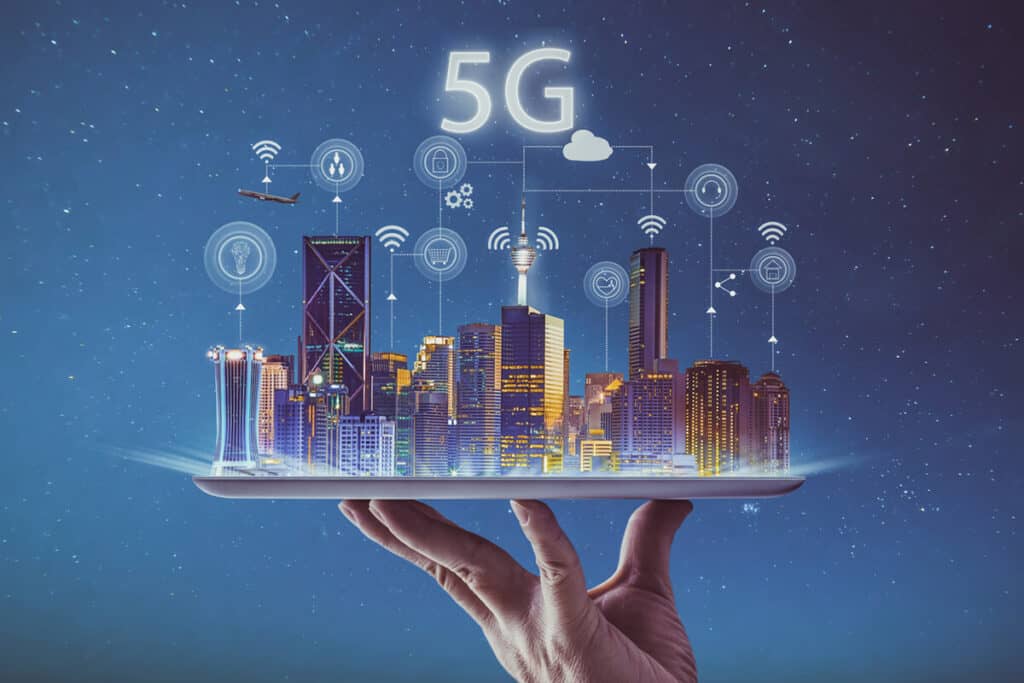
Why Is 5G So Important?
With its minimal network latency and potential to support millions of devices at ultra-fast speeds, 5G is important for a number of reasons.
5G has the potential to greatly extend the reach of mobile broadband. For communications, the quality of voice calls made over any Voice over Internet Protocol (VoIP) service such as Skype, WhatsApp, or Zoom will be very much sharper and clearer than on the phone network.
What’s more, Voice over 5G (Vo5G) services will enable improved video calling, telepresence, augmented reality (AR), and virtual reality (VR) applications.
Under the mMTC (massive Machine Type Communications) specification of 5G, networks should be able to accommodate up to a million connected devices per square kilometer.
This kind of mass connectivity with minimal latency could, for example, make it possible for live audiences at stadiums to stream events via their phone or tablet to viewers at home.
The URLLC (Ultra-Reliable and Low Latency Communications) specification of 5G allows for reliable, instant communications between devices and the network.
For autonomous or “driverless” vehicles, this allows vehicles to communicate their exact speed and position with each other in real or near real-time.
This kind of communication would make it possible for autonomous vehicles to steer and react with acceptable margins of safety. It would also open the door for “platooning” – a scenario where groups of vehicles in a connected convoy will be able to drive with a one-second gap between each vehicle, automatically matching each other’s speed and braking patterns.
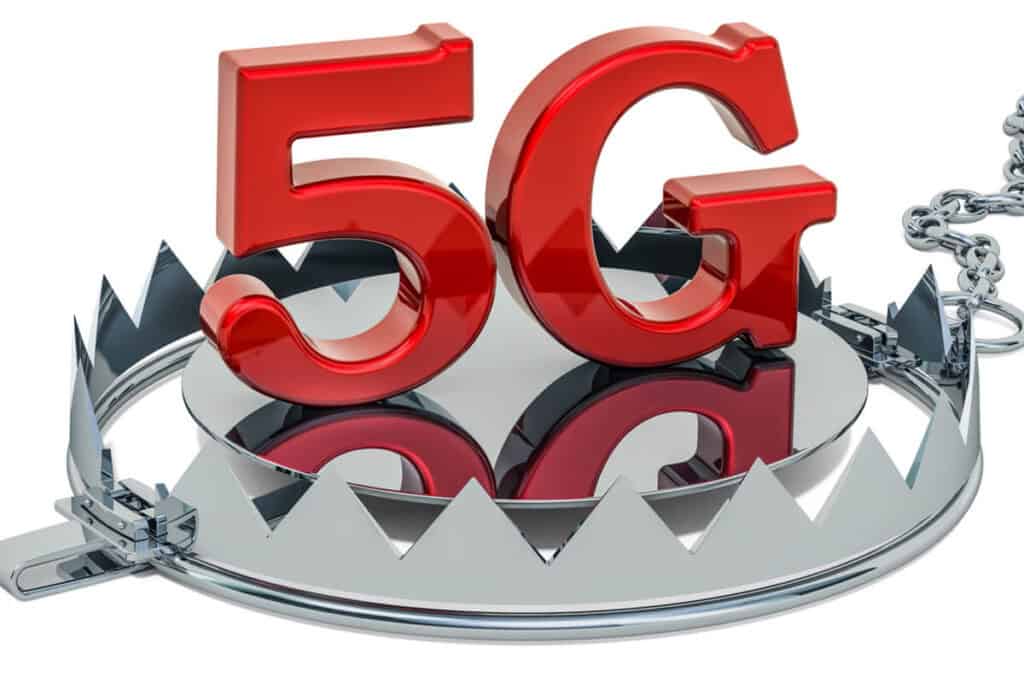
What Makes 5G Dangerous?
One of the biggest concerns about 5G is the potential cancer risk associated with the installation of many more antennas in urban areas, transmitting the radio frequency (RF) waves needed to create 5G networks.
However, studies conducted by respectable authorities including the US Food and Drug Administration (FDA), the Federal Communications Commission (FCC), the National Cancer Institute, and the International Commission on Non-Ionizing Radiation Protection (ICNIRP) suggest that the levels of radiation emitted by 5G infrastructure and equipment will be well within safe limits.
A number of other concerns about the dangers of 5G have been voiced, notably via online conspiracy theories linking the new technology – erroneously – to the outbreak and spread of COVID-19, and the death of flocks of flying birds.
The greatest danger so far exhibited by 5G has been in the hype and reaction to these stories. Several acts of arson and vandalism have been perpetrated against 5G infrastructure in the UK and elsewhere, as a result.
Which Country Has 5G Network?
South Korea, China, and the United States currently lead the world in building and deploying 5G technology. As of January 2020, commercial 5G networks have been deployed in 378 cities across 34 countries. These include:
Austria, Estonia, Finland, Germany, Hungary, Ireland, Italy, Latvia, Lithuania, Monaco, Poland, Romania, San Marino, Spain, Sweden, Switzerland, and the UK, in Europe.
Suriname, Trinidad & Tobago, the US, and Uruguay, in North and South America.
Bahrain, Kuwait, Lesotho, Oman, Qatar, Saudi Arabia, South Africa, and the United Arab Emirates (UAE), in the Middle East and Africa.
Australia, China, the Maldives, New Zealand, and South Korea, in Asia and Oceania.

How Does 5G Technology Work?
Advancing on previous generations of mobile technology, 5G introduces three new aspects: bigger channels (which speed up data transfer), lower latency (which reduces lag, and makes networks more responsive), and the ability to connect a lot more devices at once (for sensors and smart devices).
Initially, 5G installations constitute a “non-standalone,” or NSA, network. They have this designation because all 5G devices in the US, for now, require the presence of a 4G network to make initial connections before trading up to 5G where it’s available.
Later this year, 5G networks will become “standalone,” or SA, not needing 4G coverage to work.
5G can run on any frequency, so there are 5G variants on the low, middle, and high band frequency spectrum. 5G speeds are directly related to the width of the available channels, and how many channels are available.
With current phones in the low and mid-band 5G spectrum, it’s possible to combine two 100MHz channels, for 200MHz usage, and to add three more 20MHz 4G channels on top of that. In high-band 5G, you can use up to eight 100MHz channels.
In early 5G installations piggybacking on 4G, networks need to erect frequency barriers between their 4G and 5G channels. But with the introduction of dynamic spectrum sharing or DSS technology, carriers can dynamically split channels between 4G and 5G, based on demand.
High-band 5G or millimeter-wave (mmWave) uses radio waves with a very short range, typically demanding about 800-foot distances between towers.
mmWave gives very high speeds, but poor penetration of solid barriers, so large numbers of small base station antennas or “small cells” are required to maintain coverage.
Just like other cellular networks, 5G networks use a system of cell sites to divide their territory into sectors and send encoded data through radio waves. Each cell must be connected to a network backbone, either through a wired or wireless backhaul connection.
In many major cities, carriers installed these “small cells” to increase 4G capacity starting in 2017. For their 5G implementations, they only need to bolt an extra radio onto existing sites.
Elsewhere, however, carriers will need to convince municipal authorities to let them add small cells to suburban neighborhoods.
What’s the Big Deal with 5G?
If it lives up to its promise, 5G will provide the speed, low latency, and connectivity needed to facilitate a new generation of applications, services, and business opportunities.
For the growing Internet of Things, massive machine-to-machine communications under 5G will enable us to connect billions of devices without human intervention at a scale never seen before.
This could revolutionize processes and applications in various sectors, including agriculture, manufacturing, health care, and business communications.
With ultra-reliable low latency communications, mission-critical and real-time operations such as the control of industrial robotics, vehicle-to-vehicle communications, and automated safety systems could become commonplace under 5G.
This could also make remote medical care, procedures, and treatment a practical reality.
Enhanced mobile broadband under 5G could provide fixed wireless internet access for homes, outdoor broadcast applications without the need for external broadcast units, and greater connectivity for people on the move.
Combined with data analytics and artificial intelligence (AI), 5G, and IoT could enable organizations to gain insights into their operations in new ways. This could pave the way for innovation, cost savings, and improved customer experiences.

